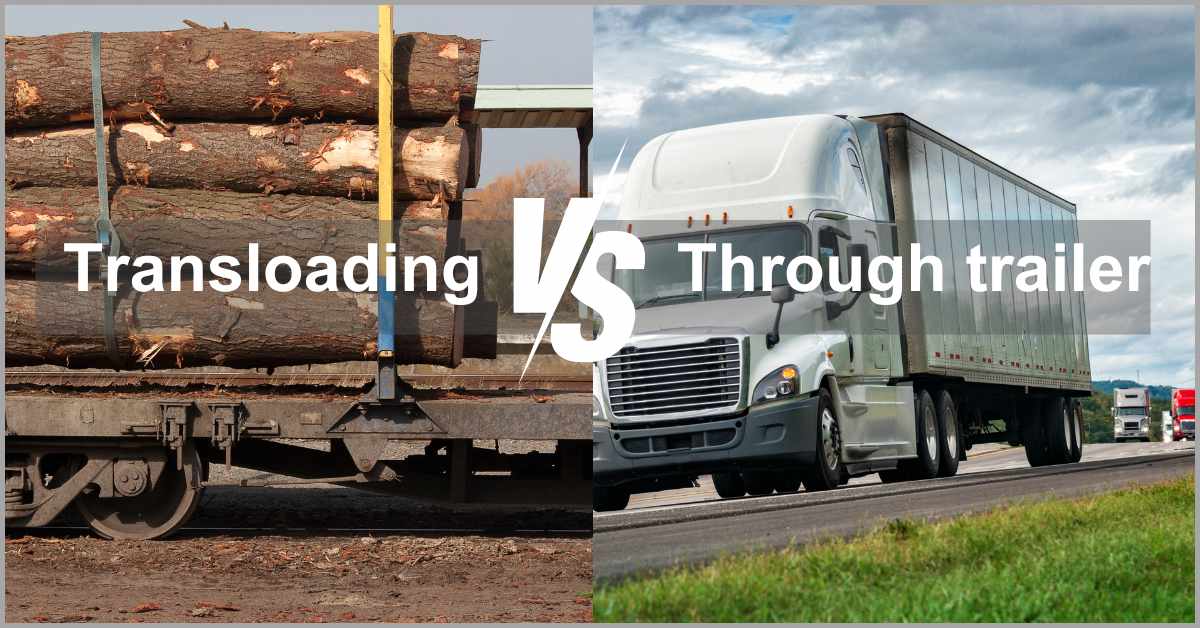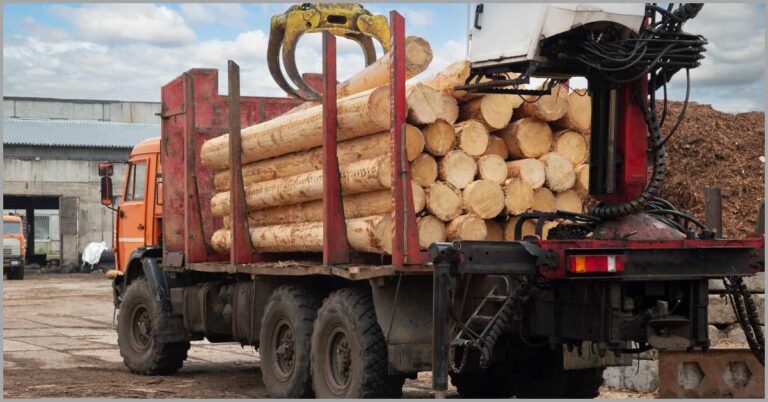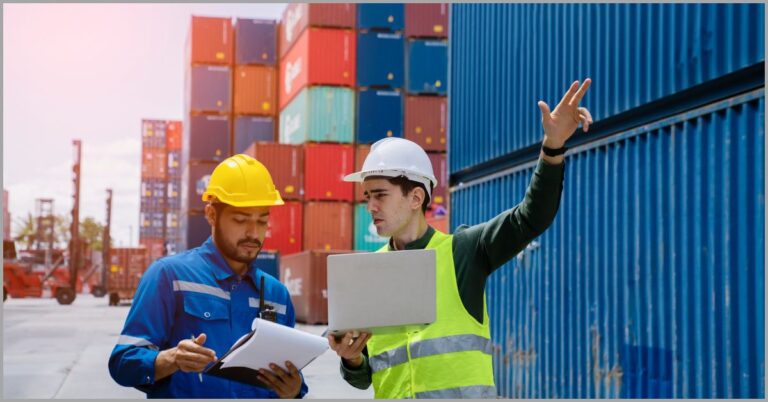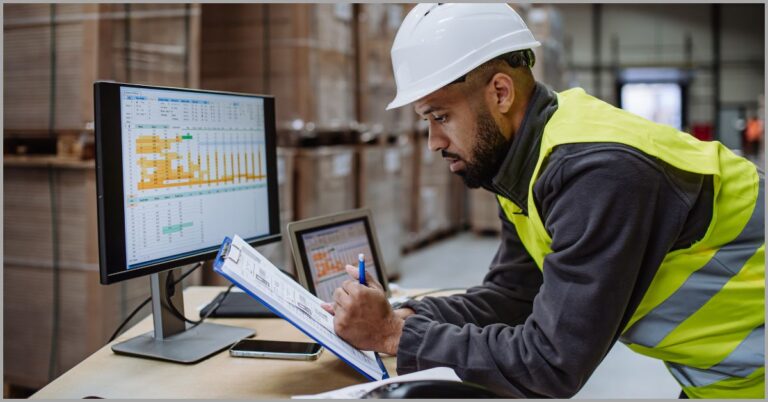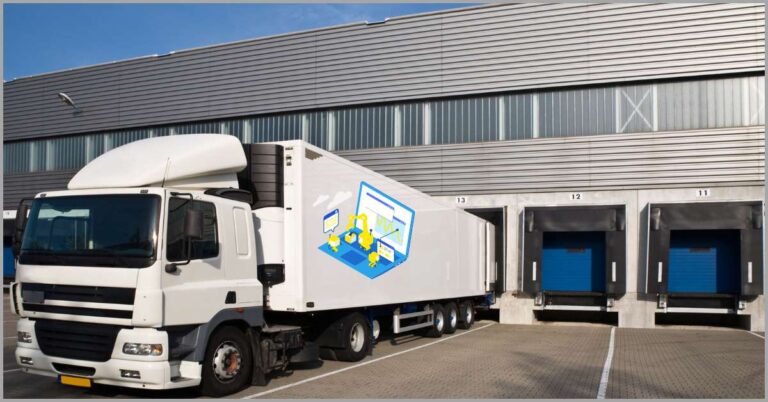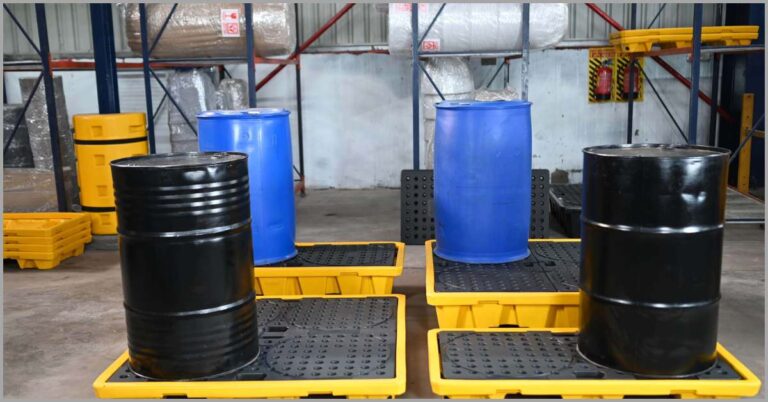Transloading vs Through Trailer: 5 Differences & How to Choose a Service
Looking for a suitable shipping strategy?
Through trailer and transload freight shipping result in very different shipping outcomes.
If you fail to make the right decision about your shipping strategy, you may not meet your business’s shipping goals in terms of costs or timelines.
A study by Anvyl revealed that 79% of businesses reported supply chain revenue losses because of disruptions. Inefficient shipping was a huge contributor.
In order to help you find the right shipping strategy, we’ll venture into the transloading vs through trailer discussion and comprehensively assess each strategy so that you can make a more informed decision for your supply chain.
This knowledge will also help you to choose a shipping method that matches your goals and the type of cargo you’re moving to increase cost-effectiveness.
If you’d like to explore other shipping options for your business, check out this article I wrote on transloading vs cross docking shipping approaches.
In this article, we’ll discuss the key differences between transloading vs through trailer shipping and how to choose a service that fits your needs best.
Let’s get started.
1. What is transloading and through trailer shipping?
I. Transload shipping
Transloading is a very popular shipping strategy.
It involves the exchange of freight across different forms of transportation. For example, switching cargo from truck to railcar or vice versa counts as transloading, and so too does switching freight from one truck to another or from one rail car to another.
During shipping, transport costs can really stack up but transloading enables you to use the most economical transport options across each phase of the journey.
If you’re shipping goods overland across long distances, for instance, transloading enables you to take advantage of crucial rail road logistics strategies to move your cargo from trucks to rail carriers that tend to be more cost-effective over long distances.
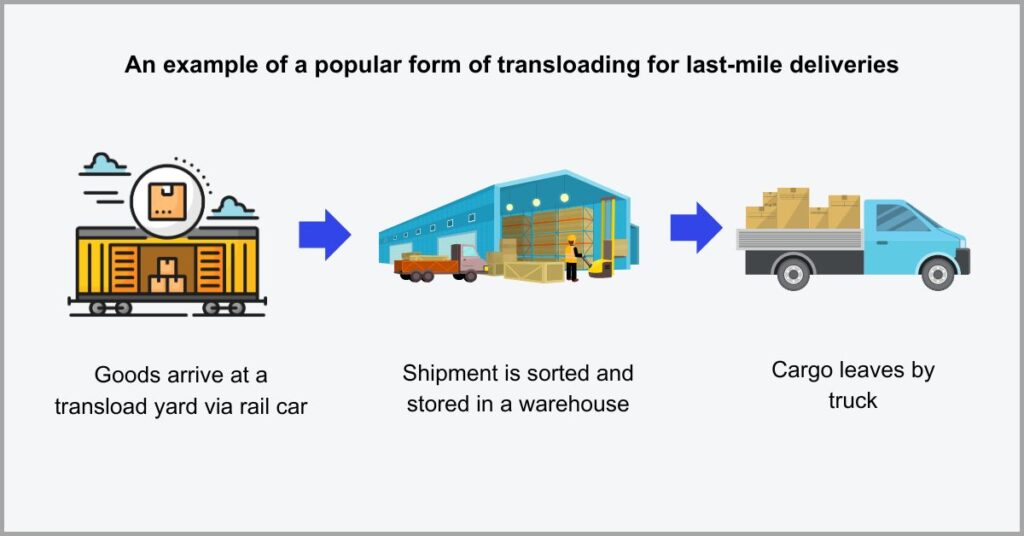
For shorter trips, even the best transload service companies will likely suggest that you switch your freight over from rail to trucks as this form of transportation is now cheaper.
That said, one key difference between transload vs through trailer is that transloading often occurs at a dedicated facility such as a transload terminal or yard.Through trailer shipping, however, eliminates the need for a dedicated facility.
At the transload yard, dock workers will often palletize your goods, store them temporarily in a transload warehouse, and even consolidate your shipment with other cargo to enable truck or rail car sharing.
II. Through trailer shipping
What is through trailer shipping exactly?
It entails goods staying in the same trailer for the entirety of the shipping process. The consignment is never opened at any point, however, this can change if you’re shipping cross-border because customs officials may need to inspect the trailer’s contents.
In cases where frequent handling can increase the risk of damage, through trailer eliminates material handling through truck-to-truck trailer exchanges.
Let’s demonstrate this type of shipping with an example.
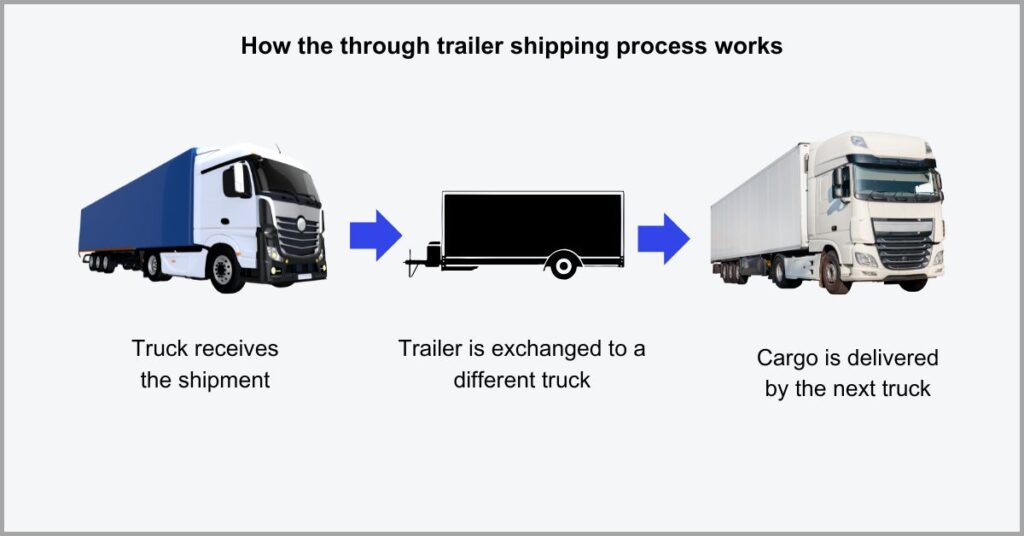
For instance, imagine you’re starting a transload warehouse business and your client has requested through-trailer shipping. The manufacturer, based in Mexico, has already bundled the shipment into a trailer that you need to transport across borders to the US.
In this case, you can send a truck to get the trailer for the first-mile delivery. While goods stay within the same trailer, it is possible for you to switch trucks.
You can switch to a different truck for the last-mile delivery or at any other point of the journey as needed, but at no point do you open the trailer. It remains intact through the journey until it reaches the consignee who can now break open the shipment.
Differences between transloading and through trailer
1. Shipment opening
How is transloading different from through trailer?
One key difference arises in terms of whether the shipment is opened or not. In transloading, you may need to deconsolidate the shipment to send out to different destinations, so you’ll need to open the trailer.
So transloading enables freight deconsolidation and consolidation, the absence of which can lead you to miss out on cost-saving opportunities.
In fact, you can reduce shipping costs by 23% through freight consolidation and truck sharing, according to a study by Oklahoma State University. So if it costs $10,000 to move a shipment, that can mean spending $2,300 less.
This proves the significant cost-savings of transloading vs through trailer for your business.
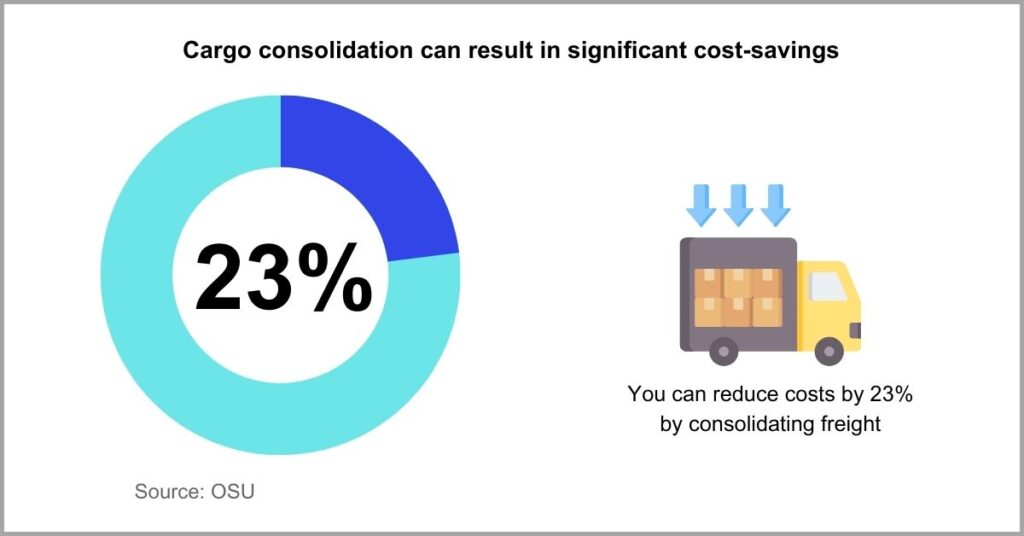
On the other hand, you never open the consignment in through trailer shipping.
The shipment remains within this vessel, typically a container, which remains shut and sealed throughout the process. However, this doesn’t mean that you can’t switch between different types of transportation.
Just like it’s the cash with transloading and intermodal shipping, you can also transfer the cargo from one truck to another. So the vehicle or driver that receives the initial shipment may not be the same one completing the delivery.
While this strategy can inflate shipping costs, it’s a wise technique for transporting temperature-sensitive and extremely fragile freight that require very minimal handling.
2. Modes of transportation
Transloading may rope in different types of transport.
For instance, your freight can start its first-mile journey on a container on an ocean vessel. Once it gets to land, you can transload into an awaiting truck or rail car.
Beyond cost-savings, transloading makes it possible to reach destinations that may have poor road infrastructure or are experiencing bad weather.
Unfortunately, a study by Make UK unearthed that 68% of manufacturers in the UK said road infrastructure has gotten worse in recent years. This has made road freight transportation more costly and rendered certain destinations inaccessible.
With transloading, it’s possible to switch from truck to rail to solve infrastructure challenges.
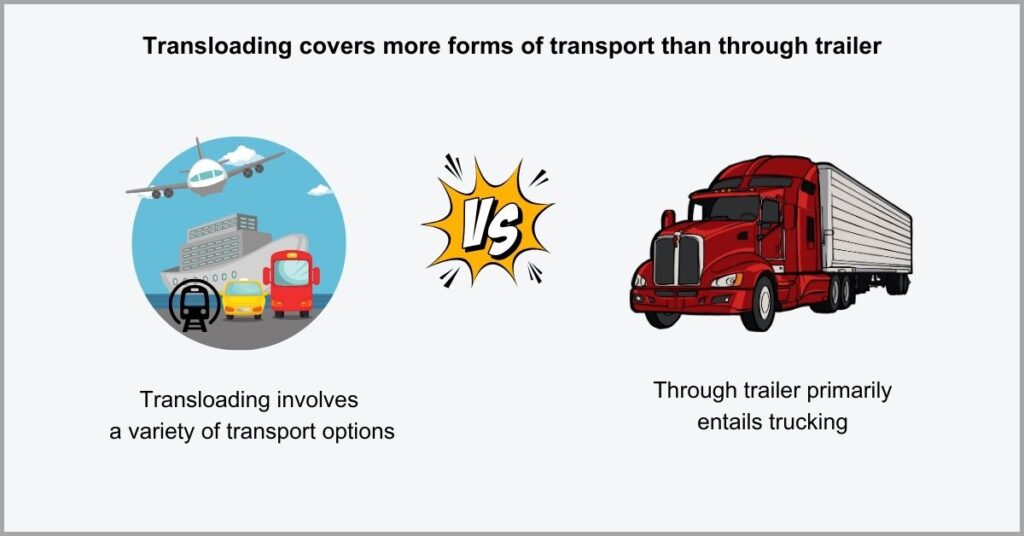
Does through trailer switch forms of transportation?
Yes. However, another key factor in the transloading vs through trailer shipping debate , is that the latter typically happens between trucks, while transloading can involve switching between sea, rail and even air transportation so there’s more variety.
If you’re torn between the two strategies and want to choose between offering one shipping service or the other, we can help.
Click here to get our premium support services for reliable transloading consultancy.
We’ll learn more about the goals for your business, your infrastructure and other unique needs to advise on a shipping strategy and assist you set up an efficient transload yard.
3. Type of cargo
What types of goods does transload shipping handle?
Well, you can transload just about everything, including but not limited to pipe, lumber, metal and bricks. However, the key transloading vs through trailer difference here is that goods are often palletized and therefore not floor loaded.
With floor loaded and non-palletized freight, there’s a greater risk of cargo damage since your shipment is in direct contact with the surface of the container.
A survey by PRG revealed that 44% of shippers plan to increase their use of pallets. This is fueled by the many benefits it offers, including the ability to cushion and protect cargo from physical damage as well as greater security.
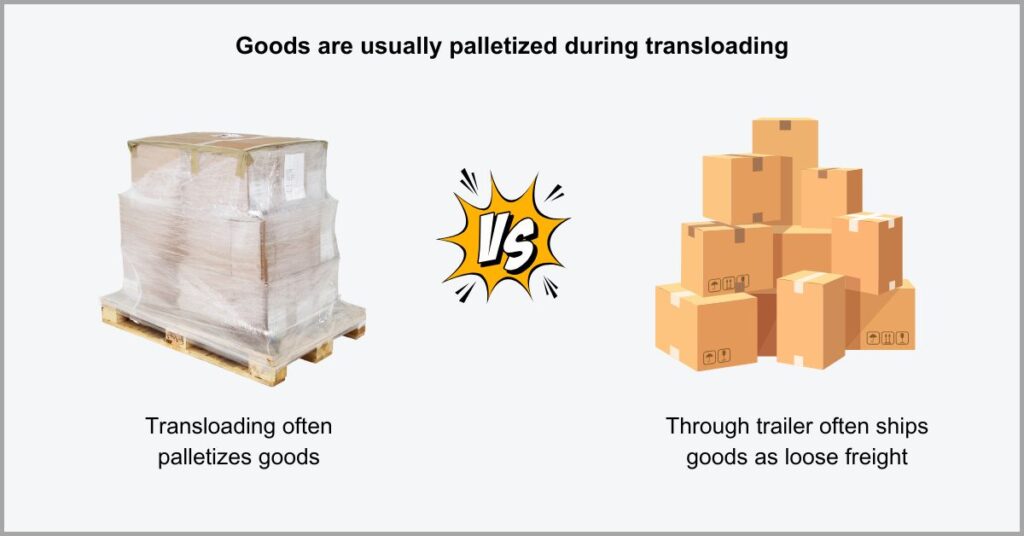
With through trailer shipping, the consignor typically doesn’t palletize goods, with this process commonly carried out at a transloading warehouse.
Although I don’t rule out palletization completely, it’s often the case that your shipment will be floor loaded and transported as loose freight such as boxes within cartons.
With that in mind, through trailer can aggravate the challenges of transloading such as cargo damage due to there being very little protection in terms of padding between the trailer or its container and your shipment.
That said, your consignor may still offer other forms of cargo reinforcement including roller cradlers and internal bracers that help to reduce freight movement during transit.
4. Warehousing needs
Transload shipping typically involves a warehouse.
Your shipment will move from the consignor to this location, where your cargo is sorted and potentially even stored for some time awaiting pickup by the next truck or rail car.
So transloading attracts extra warehousing expenses, which can inflate your shipping costs and invite additional shipping delays for your business.
A study by WarehouseQuote showed a 4% rise in warehousing costs between 2023 and 2022. When warehousing costs go up, transloaders may pass on some of the expenses to the customer to offset losses.
That said, transloading still presents massive cost savings by enabling you to switch from long-distance trucking to cheaper rail transportation.
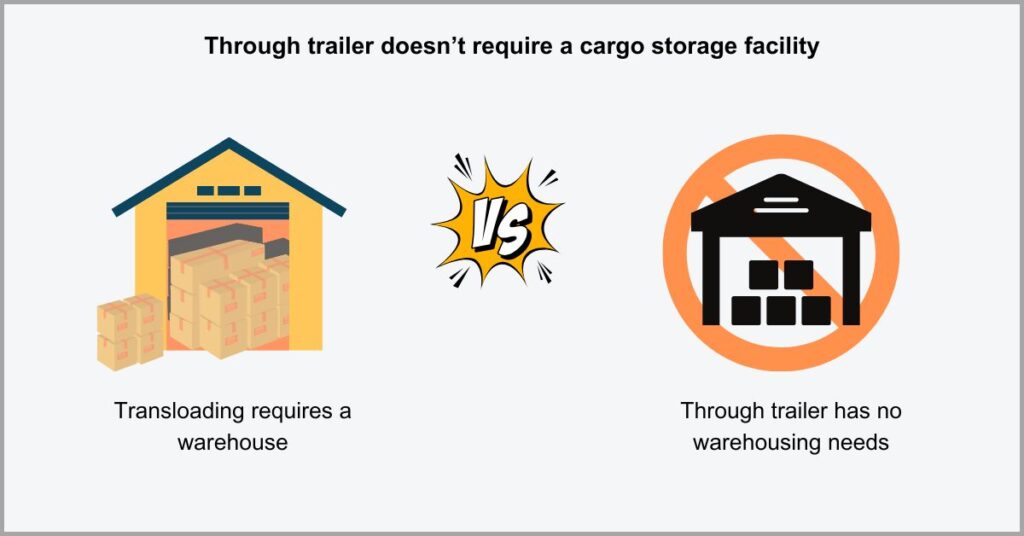
Through trailer, meanwhile, negates the need for a warehouse.
In fact, there’s very little need for storage whatsoever because goods remain in one trailer. This makes it one of the most effective logistics strategies among carriers who have limited warehousing space or lack a storage facility altogether.
If we approach the transloading vs through trailer discussion from the perspective of cost, however, transloading carries the day despite additional warehousing expenses.
This is because carriers tend to charge more for through trailer services due to limited flexibility in terms of shipment size, scarcity of the service and therefore less competition to deal with, and the need for dedicated shipping resources such as drivers and trucks.
5. Security seal breakage
What is a security seal for shipments?
It’s essentially a strategy for making your freight more tamper proof during shipping, and it works similarly to a warranty sticker, in that it helps to prove that the consignment wasn’t opened at any point during the shipping process.
During transloading, your security seals on containers are often broken in order to access & palletize goods, which can raise cargo accountability issues.
A study by CargoNet established a 46% increase in cargo theft incidents between 2023 and 2024. One of the top targets included transloaded goods stored at warehousing and distribution centers awaiting pick up.
So this certainly presents one alarming risk that comes with transloading.
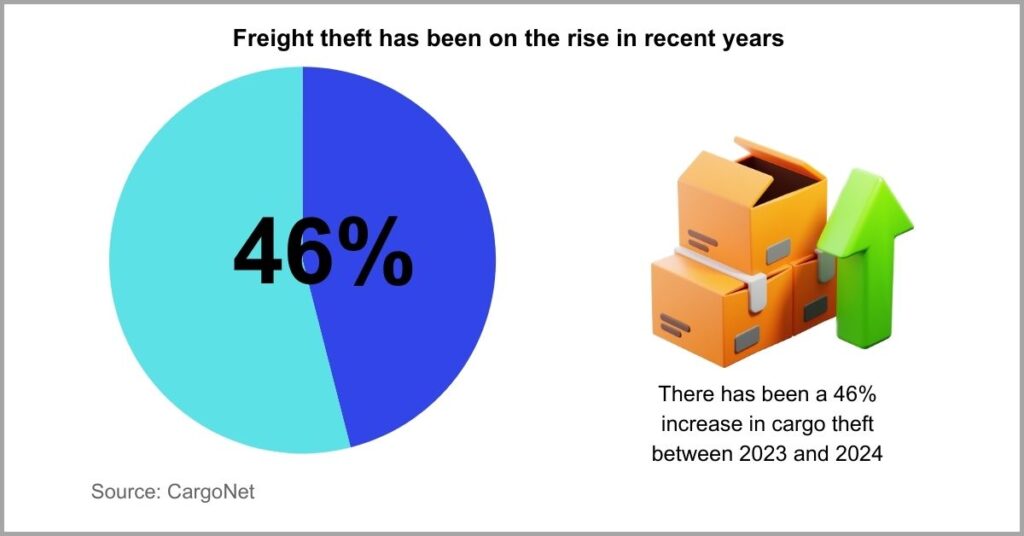
Meanwhile, it’s very likely that your security seal will remain intact during through-trailer shipping.
This is because your trailer will move from the dock door of the consignor right to your very own dock with minimal handling, which also means greater security for your cargo.
That said, investing in warehouse management technology can also improve security.
Click here to start your free transloads.co trial to get a great transload management software to help you monitor freight during transit more comprehensively.
With our solution, you can even tag pallets with bar codes to enable traceability and enhance inventory visibility. This greatly reduces the risk of shrinkage and inventory errors as well.
How to choose between transloading & through trailer
a) Consider cargo value
Are you moving very high-value cargo?
If you are, then transload shipping may not be the best option. This is because it involves the unloading and often repacking of freight to enable optimal movement.
While transloading enables more efficient shipping, it can expose your freight to increased risks of damage and theft due to the repacking process.
For these reasons, transloading may not be ideal if you’re moving very high-value shipments like luxury items and hi-tech electronics. Although it offers great flexibility to move just about any type of cargo when you’re working with mid to low value goods.
So in this transloading vs through trailer shipping discussion, I recommend taking the through trailer option for high value cargo that’s highly susceptible to theft or damage.
That’s because your merchandise will remain undisturbed in the trailer throughout the journey, just like what happens during intermodal cargo shipping, where your shipment never leaves the intermodal container.
With repackaging and even the sorting of individual goods eliminated, there’s a lower risk of inventory shrinkage thereby increasing the safety of your consignment.
What’s more, the security seal of the trailer also usually remains unbroken, enabling you to assess cargo integrity which bolsters freight security even more.
b) Assess time vs cost-effectiveness
Need to move your goods more cost-efficiently?
If cost plays a huge part in your shipping decisions, I recommend transloading. It delivers huge cost-savings that can help you move goods to clients more affordably.
Overall, transloading is the better choice if you’d like to avoid high shipping costs and negotiate better carrier rates across different forms of transportation.
Another way this strategy lowers expenses is through palletization and repacking.
This enables you to easily stack, nest and mix cargo, which allows you to achieve very high container utilization rates. So you’ll move freight in fewer shipments, therefore avoiding extra shipping expenses.
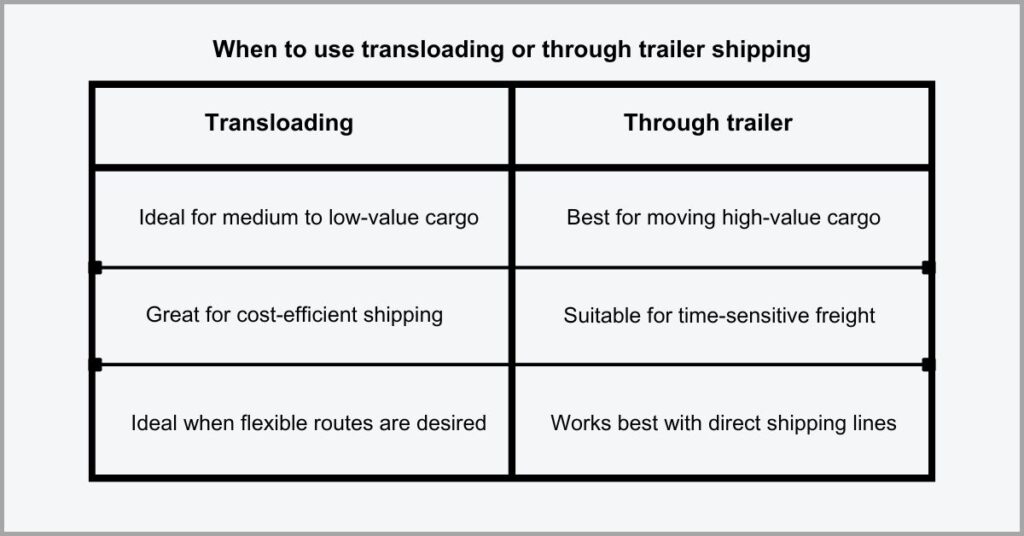
Conversely, unlike transload freight shipping, through trailer is very expensive.
Carriers may charge you an arm and a leg for this service and cost efficiency also greatly declines when you’re moving lower shipment volumes.
But if urgency is a bigger priority than costs, through trailer is the better choice.
Since it eliminates goods handling, unnecessary stops, and warehouse storage, this shipping strategy allows you to move time-sensitive products very quickly across your supply chain.
So when you’re faced with very low turnaround times in terms of delivering shipments to your customers, a through trailer shipping strategy is an excellent option to consider.
c) Examine your shipping routes
Do you have direct shipping lines in the region?
This is an important question to have at the back of your mind when you’re weighing your options between transloading vs through trailer for shipping your freight.
In certain areas, you may not have direct shipping lanes due to poor road access and other factors, which can make traditional solutions like trucking expensive.
Transloading is the shrewd logistics strategy in this case because it offers more flexibility for your business in terms of shipping routes. You can make adjustments to take alternative shipping options by water or rail to create new shipping lines.
Meanwhile, through trailer is very rigid when it comes to routes.
Unlike transloading which enables efficient railroad switching and truck to railcar cargo exchanges, through trailer exclusively involves trucking, which requires well-established road networks in order to make it a feasible logistic strategy for your businesses
As a result, you may need to truck longer distances than you would with other types of transport to avoid poor infrastructure, adding delays and costs to your supply chain.
So through trailer becomes a logistics strategy that’s most ideal in regions or geographical zones where you have direct shipping lines particularly by road.
Conclusion
Shipping costs are through the roof today.
Some of the top reasons include container shortages, inefficient cargo shipping and economic inflation.
When your shipping costs are too high, they erode your business’s profit margins, necessitating price hikes that decrease client satisfaction.
Alarmingly, a Software Advice survey revealed that 45% of businesses said economic inflation is their biggest supply chain concern. As times get tough, choosing the right shipping strategy can help alleviate financial strains.
With the discussion we’ve had around transloading vs through trailer, you can now make the right decision that results in profitable shipping. Speaking of which, our transload management software can also help you become more cost-efficient.
Click here to start your free transloads.co trial and use our proven platform to lower logistics expenses for your business.
Our platform saves your financial resources by improving inventory accuracy and automating various iterative shipping tasks to reduce your labor and resource needs.

